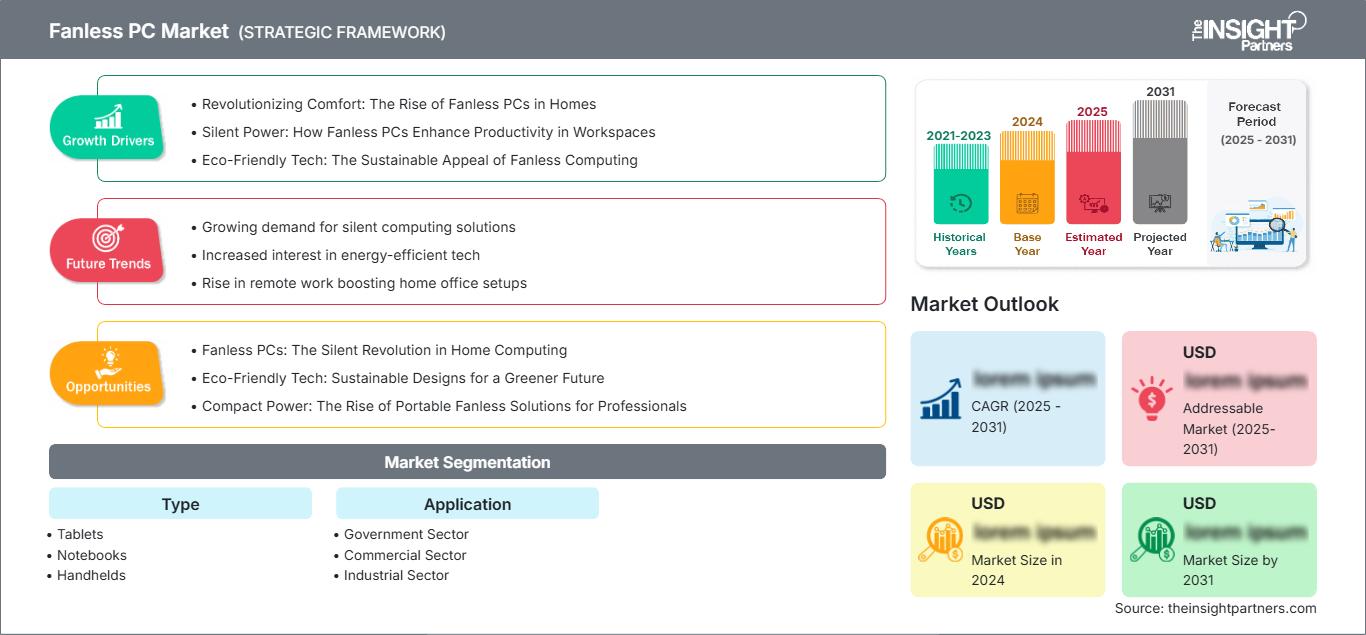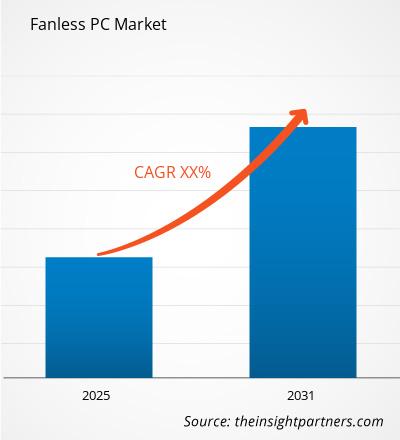Se espera que el mercado de PC sin ventilador registre una CAGR del XX% entre 2025 y 2031, con un tamaño de mercado que se expandirá de US$ XX millones en 2024 a US$ XX millones en 2031.
El informe se clasifica por tipo (tabletas, portátiles, dispositivos portátiles, PC) y analiza el mercado en profundidad según su aplicación (sector gubernamental, sector comercial, sector industrial, sector militar y de defensa). Se ofrece un desglose completo a nivel global, regional y nacional para cada uno de estos segmentos clave.
El informe incluye el tamaño del mercado y las previsiones para todos los segmentos, con valores en USD. También ofrece estadísticas clave sobre el estado actual del mercado de las principales empresas, junto con información sobre las tendencias actuales del mercado y las oportunidades emergentes.
Propósito del Informe
El informe "Mercado de PC sin ventilador" de The Insight Partners busca describir el panorama actual y el crecimiento futuro, los principales factores impulsores, los desafíos y las oportunidades. Esto proporcionará información a diversas partes interesadas del negocio, como:
- Proveedores/fabricantes de tecnología: Para comprender la dinámica cambiante del mercado y conocer las oportunidades potenciales de crecimiento, lo que les permitirá tomar decisiones estratégicas informadas.
- Inversores: Realizar un análisis exhaustivo de tendencias respecto a la tasa de crecimiento del mercado, las proyecciones financieras del mercado y las oportunidades que existen en toda la cadena de valor.
- Órganos reguladores: Regular las políticas y las actividades policiales en el mercado con el objetivo de minimizar el abuso, preservar la confianza de los inversores y defender la integridad y estabilidad del mercado.
Segmentación del mercado de PC sin ventilador
Tipo
- Tabletas
- Cuadernos
- Dispositivos portátiles
- PC
Solicitud
- Sector gubernamental
- Sector comercial
- Sector industrial
- Sector de Defensa y Militar
Obtendrá personalización en cualquier informe, sin cargo, incluidas partes de este informe o análisis a nivel de país, paquete de datos de Excel, así como también grandes ofertas y descuentos para empresas emergentes y universidades.
Mercado de PC sin ventilador: Perspectivas estratégicas

-
Obtenga las principales tendencias clave del mercado de este informe.Esta muestra GRATUITA incluirá análisis de datos, desde tendencias del mercado hasta estimaciones y pronósticos.
Factores que impulsan el crecimiento del mercado de PC sin ventilador
- Revolucionando la comodidad: el auge de las PC sin ventilador en los hogares
- Energía silenciosa: cómo las PC sin ventilador mejoran la productividad en los espacios de trabajo
- Tecnología ecológica: el atractivo sostenible de la informática sin ventilador
Tendencias futuras del mercado de PC sin ventilador
- Creciente demanda de soluciones informáticas silenciosas
- Aumento del interés en la tecnología de eficiencia energética
- El aumento del trabajo remoto impulsa la configuración de oficinas en casa
Oportunidades de mercado para PC sin ventilador
- PC sin ventilador: la revolución silenciosa en la informática doméstica
- Tecnología ecológica: diseños sostenibles para un futuro más verde
- Compact Power: El auge de las soluciones portátiles sin ventilador para profesionales
Perspectivas regionales del mercado de PC sin ventilador
Los analistas de The Insight Partners han explicado detalladamente las tendencias regionales y los factores que influyen en el mercado de PC sin ventilador durante el período de pronóstico. Esta sección también analiza los segmentos y la geografía del mercado de PC sin ventilador en Norteamérica, Europa, Asia Pacífico, Oriente Medio y África, y Sudamérica y Centroamérica.
Alcance del informe de mercado de PC sin ventilador
| Atributo del informe | Detalles |
|---|---|
| Tamaño del mercado en 2024 | US$ XX millones |
| Tamaño del mercado en 2031 | US$ XX millones |
| CAGR global (2025-2031) | XX% |
| Datos históricos | 2021-2023 |
| Período de pronóstico | 2025-2031 |
| Segmentos cubiertos |
Por tipo
|
| Regiones y países cubiertos |
América del norte
|
| Líderes del mercado y perfiles de empresas clave |
|
Densidad de participantes en el mercado de PC sin ventilador: comprensión de su impacto en la dinámica empresarial
El mercado de PC sin ventilador está creciendo rápidamente, impulsado por la creciente demanda de los usuarios finales debido a factores como la evolución de las preferencias de los consumidores, los avances tecnológicos y un mayor conocimiento de las ventajas del producto. A medida que aumenta la demanda, las empresas amplían su oferta, innovan para satisfacer las necesidades de los consumidores y aprovechan las tendencias emergentes, lo que impulsa aún más el crecimiento del mercado.

- Obtenga una descripción general de los principales actores clave del mercado de PC sin ventilador
Puntos clave de venta
- Cobertura integral: el informe cubre exhaustivamente el análisis de productos, servicios, tipos y usuarios finales del mercado de PC sin ventilador, proporcionando un panorama holístico.
- Análisis de expertos: el informe se compila con base en el conocimiento profundo de expertos y analistas de la industria.
- Información actualizada: El informe asegura relevancia comercial debido a su cobertura de información reciente y tendencias de datos.
- Opciones de personalización: este informe se puede personalizar para satisfacer los requisitos específicos del cliente y adaptarse adecuadamente a las estrategias comerciales.
Por lo tanto, el informe de investigación sobre el mercado de PC sin ventilador puede ayudar a descifrar y comprender el panorama de la industria y sus perspectivas de crecimiento. Si bien existen algunas preocupaciones válidas, las ventajas generales de este informe tienden a superar las desventajas.
- Análisis histórico (2 años), año base, pronóstico (7 años) con CAGR
- Análisis PEST y FODA
- Tamaño del mercado, valor/volumen: global, regional y nacional
- Industria y panorama competitivo
- Conjunto de datos de Excel
Informes recientes
Testimonios
Razón para comprar
- Toma de decisiones informada
- Comprensión de la dinámica del mercado
- Análisis competitivo
- Información sobre clientes
- Pronósticos del mercado
- Mitigación de riesgos
- Planificación estratégica
- Justificación de la inversión
- Identificación de mercados emergentes
- Mejora de las estrategias de marketing
- Impulso de la eficiencia operativa
- Alineación con las tendencias regulatorias






















 Obtenga una muestra gratuita para - Mercado de PC sin ventilador
Obtenga una muestra gratuita para - Mercado de PC sin ventilador